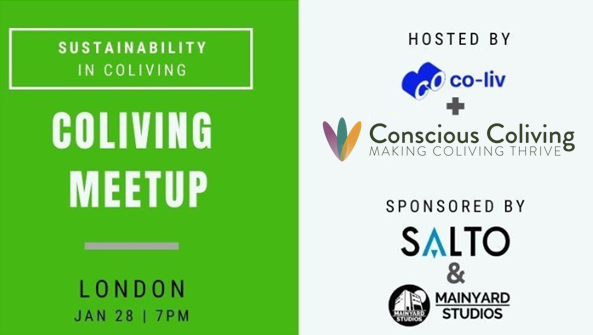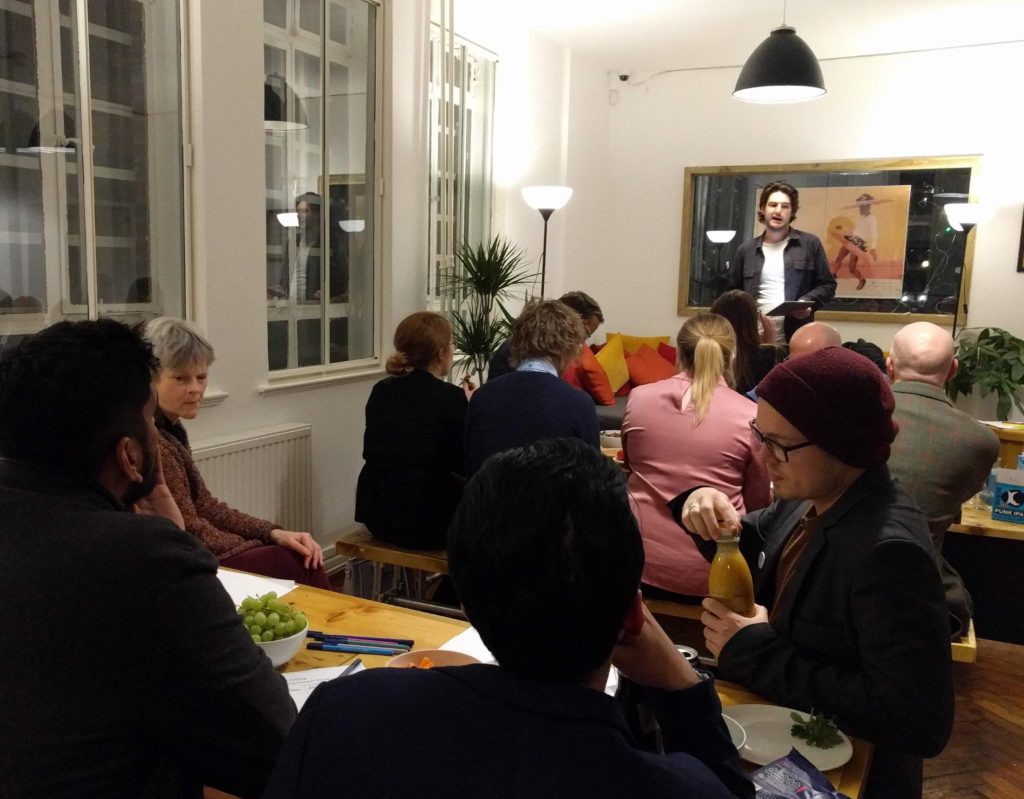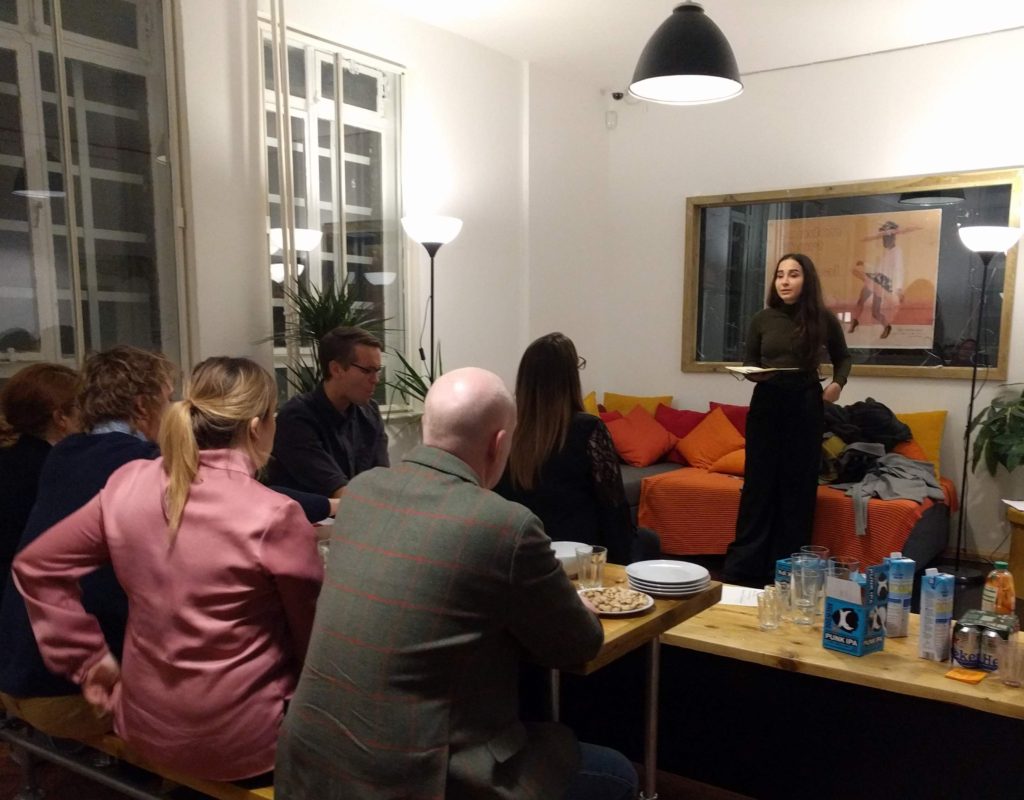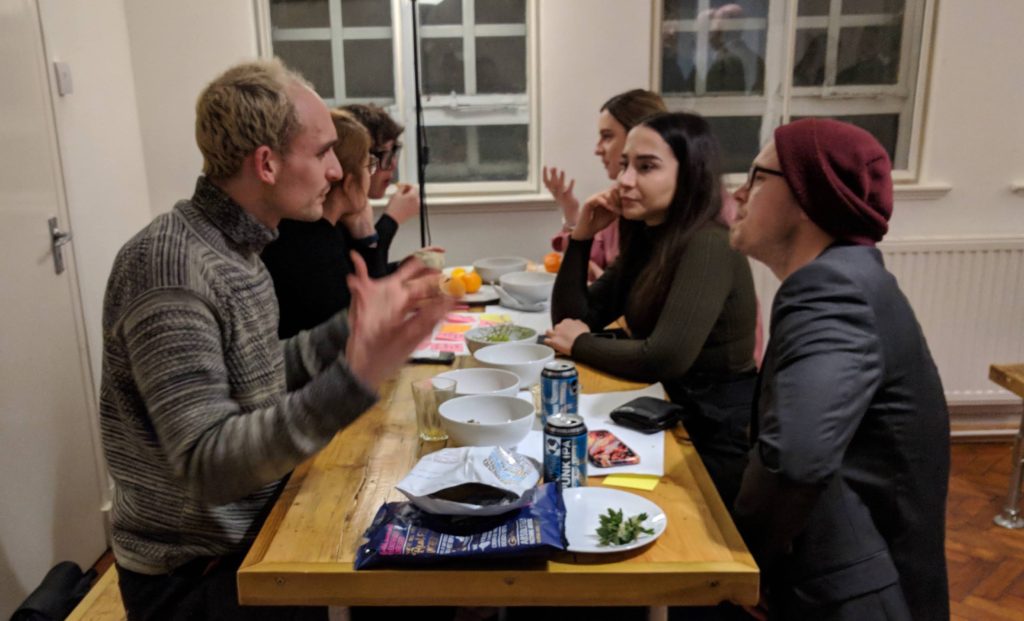Environmental sustainability is rising on the list of priorities for both investors and consumers. It’s an especially important topic in the case of the built environment, which accounts for 40% of UK carbon emissions (UKGBC, 2020).
How to enable environmental sustainability in coliving was the theme of our third London Coliving meetup, where we got together with coliving and coworking operators, property and housing developers, architects, consultants, and others with professional or personal interests in the coliving industry.

The Speakers
The evening was kicked off with talks from our two special guest speakers.
First, we heard from James Scott, co-founder of Stories, a socially responsible property developer. James worked at The Collective before leaving and founding Stories, which was driven by the desire to deliver property development in a way that is fairer, and is a force for good in local areas.
James began by pointing out that a major barrier to sustainable development is that traditional financial goals are set at a 5-7 year framework, whereas our environmental targets are much longer in their scope. He emphasised that finding financial partners that align with your mission is key. He also advised using structure to ensure accountability for your own good intentions: giving Stories’ B-Corp status as an example of this.
He went on to talk about the two types of carbon in buildings: embodied carbon, which is the carbon used in the process of sourcing materials and constructing the building; and in-use carbon, which is the carbon used during the building’s life (e.g. space and water heating, repairs, energy-use). It is in-use carbon that makes up the largest portion, therefore shaping resident practices is essential in minimising global heating.
James finished his talk by remarking upon how the long-term and complex nature of climate change makes it difficult to get to grips with. He encouraged listeners to find continuing ways to reinforce the message and make climate change tangible. He recommended the following resources:

Second, we had Negin Hanjani of Wellstudio Architecture, a practice that specialises in design for wellbeing, with Negin’s expertise being in environmental design.
Negin began by saying that whilst there are several different frameworks that can be used for environmental design (e.g. BREEAM, LEED, Passivhaus) all are based on the concept of using certain technologies to lower impact. Negin advised thinking about the impact of a building as a whole, and not forgetting the construction process.
She then went on to speak about some different approaches to making an environmentally sustainable building. One in particular is refurbishment, which not only has a lower environmental impact, but also usually saves on cost and time as well.
Negin also spoke about the difference between active and passive strategies. Active strategies are where technology is used to create indefinite sources of energy e.g. solar panels, wind turbines, whereas passive strategies are design measures which take best advantage of natural cooling, heating and ventilation opportunities e.g. building orientation, windows and daylighting.
Finally, Negin spoke about how through sharing resources and increased density, coliving is a housing solution with greater levels of environmental sustainability.
Thank you to Negin and James, for such an inspiring start to the evening!

The workshop
The group then brainstormed the intervention points at which environmentally sustainable practices can be introduced. These intervention points were then grouped into three broad categories:
- Construction
- The Building
- Resident Behaviours
The group split into three to each discuss one of these topics, and then shared their thoughts at the end of the workshop. Below are some of the key insights.
1 – Enabling environmental sustainability during the construction process
- Modular building techniques increases efficiency, and means less labour on site (therefore less transport needed to the site)
- Think about repurposing existing buildings/refurbishment. As the highstreet declines, there are opportunities to convert assets from retail to residential – how might these spaces be repurposed?
- Use local resourcing for materials wherever possible. You can be imaginative in how you do this: Pollen Coliving teams up with a recycler who reuses old movie and theatre sets, which has added additional character to the coliving scheme.
- Consider the materials you use in terms of the carbon cost of their production and how they impact on in-use carbon e.g. good insulation will reduce space heating energy requirements.
- Aim to recycle as much waste generated by construction as possible.
- Build near to good transport links: this will lower the impact of transporting materials.
- Decrease the need for multiple spaces by making spaces adaptable e.g. a cafe can double up as an event space or coworking space.
- Partner with a B-Corp model to ensure prioritisation of social value as well as profit.
During discussion, Pip from Pollen Coliving mentioned how, when working with smaller contractors, education on sustainability practice was key.
2 – Environmentally sustainable building design
- Good insulation is key, as space heating uses the greatest amount of energy in buildings.
- Use sustainably sourced materials, such as sustainable timber.
- Orient the building to make the best possible use of natural light and heat.
- Use Passivhaus principles to naturally ventilate the building.
- If possible, install a system which recycles greywater into toilet cisterns.
- Make use of tools and resources such as BREEAM, LEED and WELL building standards.
- Encourage sustainable travel by making sure that the building is placed near good public transport links and pedestrian routes. Provide cycling amenities and support.
- Have shared facilities (kitchens, bathrooms, living spaces, laundrettes) to increase density, decrease energy consumption and decrease the need to buy duplicate items. This will also help to create a sense of community.
- Use responsive technology to minimise energy usage: motion-activated lights, heating on timers.
- Have adaptable spaces, which will encourage residents to use the spaces more, thereby decreasing need for transport.
- Use icons rather than written signs to encourage pro-environmental behaviours, as these are easier for residents to take notice of.
- Work with your residents: understand their needs and behaviours, and create an environment that encourages pro-environmental practices in a way that works in harmony with how they behave, e.g. placement of recycling facilities in appropriate places.
3 – Encouraging residents to engage in environmentally sustainable practices
- Residents need to know and understand their responsibilities in terms of environmental sustainability, and need to understand what the benefits are, both to themselves and to the environment. Sustainability practices, such as waste management and energy-saving behaviours, should form part of the resident induction.
- Create a strong pro-environmental culture from the start: choose residents who care about the environment for your initial community, and allow them to set the ‘norm’ for the community going forward.
- Gamification can encourage sustainable practice. Which floor can save the most energy? Make energy use measurable (using devices such as smart meters) and have a leader board.
- Have regular impact reports to celebrate what’s being done well and to identify what could be improved.
- Increasing the feeling of ownership and belonging within a community will encourage residents to take more care of their home – which can translate into things such as furniture having greater longevity, and more energy-saving behaviours.
- Empower residents to take on sustainability projects which they are passionate about e.g. growing food on allotments.
- Welcome in the local neighbourhood to sustainability-related events. Become a local hub for promoting sustainability thinking and practice.
This event was part of a series of coliving meetups, each on a different topic around coliving. You can see summaries of our London meetups on fostering wellbeing and authentic community in coliving, and you can also see summaries of our Berlin meetups, looking at wellbeing, community, environmental sustainability and the challenges of coliving too.
Stay tuned for upcoming Coliving Meetups!
Also, make sure to check out or latest on coliving design and coliving architecture.

The Sponsors
This event was sponsored by SALTO KS. SALTO Systems is proud to unlock a part of a future where there are no borders and where thought leaders from all over the globe are able to form a community that ignites creativity, productivity and health while living and working side by side. A future of Coliving that cultivates benefits like health, productivity and finance for generations to come.
If you are looking for an access control solution that can help you optimise your space in multiple ways and improve the customer experience even beyond, please contact us or Christian Schmitz (C.Schmitz@saltosystems.com).
This meetup was held at Mainyard Studios. Mainyard Studios provide affordable private offices, music studios, creative spaces and coworking to creative entrepreneurs on Bow Road in Tower Hamlets.
References
UKGBC (2020) ‘Climate Change. UKGBC’s vision for a sustainable built environment is one that mitigates and adapts to climate change.’ Available at: https://www.ukgbc.org/climate-change/ (Accessed: 7 February 2020).
This article has been coauthored for you by:
Penny is Director of Research & Sustainability at Conscious Coliving. She has an MSc in Social Research Methods, and her PhD explores how shared living may enable lowered environmental impacts. She has consulted on numerous shared living projects, specialising in impact strategy, concept, and community. Penny has presented at conferences including the Co-Liv Summit, the Urban Living Festival, BTR360 and more. She has also authored publications in The Developer, Coliving Insights Magazine, the book Urban Communal Living in Britain, as well as being interviewed by the BBC and the Guardian about shared living.
Tom Manwell is a fully qualified U.K. architect. Before founding his two current companies, Tom gained experience with a range of award winning practices working on small, medium and large scale residential schemes in London, the U.K. and Europe.
Juan is a Communications Strategist, Project Manager, Systems Engineer, Team Coach and Executive Coach with an ontological/systemic approach. Co-author of the Coliving Apps, Software & Tech Guide and contributor of The Community Facilitation Handbook. He facilitates connection for individuals, teams, and communities.